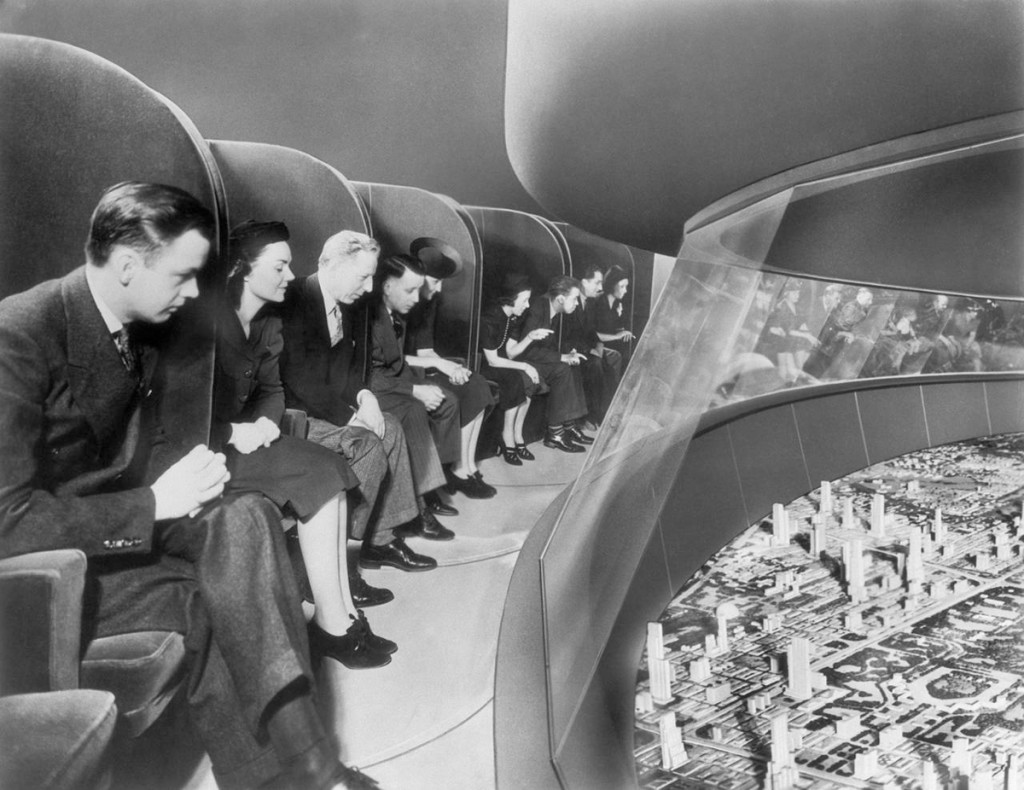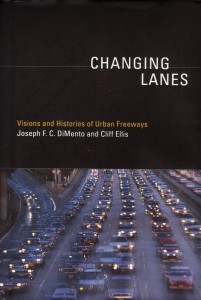Our Not-so-freeways
Mary Jane Nirdlinger
A futuristic dream carved and recast America.
When Cliff Ellis wants to visit his friends in Tulsa, Oklahoma, he gets in his car, finds a freeway, and arrives about eleven hours later. During that trip, most of us would see an unending ribbon of concrete, overpasses, exits, and, with luck, free-flowing cars. Cliff Ellis sees the results of one of our country’s greatest experiments in urban form. His new book, Changing Lanes, with coauthor Joseph F. C. DiMento, lays out the history of our freeway system as clearly as a road atlas.
In the beginning, our national system of highways grew out of a desire to connect rural areas with their markets. Dusty roads were replaced with paved routes that could carry farmers’ goods in all seasons. Beginning in the 1930s, some limited-access roads were built through urban areas, but urban freeway building didn’t really take off until the 1950s and 1960s. Controversy erupted when highway builders ran headlong into the built-up reality of our cities. The solution, as designers inked it into drawings, was elegant motorways with lush edges flowing through tidy landscapes and slicing between the high walls of modern skyscrapers. But it wasn’t that easy.
“Highway engineers, city planners, architects, and landscape architects all viewed that huge building task through different lenses,” Ellis says. “They go through different educational experiences, they approach problems differently, and they see the world through different perspectives.”
These perspectives are still at work today. “We’re facing all of the same issues, but now it’s even more important; it’s worldwide,” Ellis says. “The Chinese are building huge freeway systems, and other countries are contemplating huge systems. It’s probably not the wisest course to invest everything in freeways.”
While Ellis has captured a lot of ideas and lessons from this grand experiment with freeways in America, he respects the good intentions of the people who designed and built them.
“Highway engineers thought that everything they were building was good for cities,” Ellis says. “They were working in the public interest.” As the visionaries of the time saw it, freeways could help rid urban areas of poverty, congestion, and noise.
It was all about the future. In 1939, industrial designer Norman Bel Geddes worked with General Motors to design and build a one-acre model called Futurama for display at the New York World’s Fair. Futurama was a magnificently detailed American landscape of the future. More than five million visitors rode in upholstered seats mounted on a conveyor belt, peering down through a window as though from an airplane. A recorded narration explained the wonders of easy automobile travel on freeways connecting rural areas with towns and dazzling new cities.
Seeing the future
For the time, the vision and the technology were astonishing. “People just said, ‘Woah—what a wonderful new world is being created.’” When visitors left the Futurama exhibit, everybody got a button: “I’ve Seen the Future.” And they had.
“The kind of interstate travel we do now would have been astonishing to people in the 1920s,” Ellis says. “It’s impossible now to imagine not being able to go from city to city in comfort at high speeds.”
The system we use today is based on ideas developed in the 1930s and ‘40s. Construction took off in the 1950s, with new government funding and little opposition.
“People in specific cities said, ‘Wait a minute; you’re going to build this through a beautiful place,’ and it was stopped,” Ellis says. “But most of the proposed system was built.”
At heart, though, the freeway system was based on a rural model. “It was problematic when you took those standards and tried to smash them through the middle of downtown,” Ellis says. “Was that the wisest things to do?”
The freeway planners made great promises about how these projects would benefit inner cities. Changing Lanes documents the consistent belief that freeways would open up central business districts for reinvestment and economic growth by bringing people downtown and remedying traffic congestion. What they didn’t foresee was how those same roads would make it very easy to leave downtown or not go there at all. A whole new place evolved, a place where you could live your entire life on the edge of town.
When the freeways went into the bigger cities such as Boston, New York, and Chicago, their insertion was not a matter of delicate surgery. “They cut large swaths through dense, older neighborhoods without much concern for the people who lived there,” Ellis says.
It was this approach that eventually generated opposition to some local freeway projects, shifting the community focus from transportation to social justice and historic preservation.
There were dire predictions for the cities that dodged freeways, but, as Ellis notes, some of the best lessons come from what was not done. “Some of the proposals for lower Manhattan are appalling things to contemplate now when you think about having these massive urban freeways cutting across Washington Park,” Ellis says, “but the Cross Bronx Expressway went through similar areas.”
Some places escaped attention. Greenville, South Carolina, was a relatively small city during most of the early planning, so the major freeway is off to one side. “It has benefitted from the fact that it wasn’t really damaged by urban freeways,” Ellis says. “So have Charleston and Savannah, where the ramps come down outside the historic districts and then it’s just surface roads. Imagine if huge freeways had actually been built through the historic districts of Savannah and Charleston?”
Ellis is not saying freeways are all bad. “We need industrial routes and major arterials to get in and out. But there were alternatives that were overlooked.”
Tearing them down
Some of those alternatives appear today when freeways are removed. Ellis was in San Francisco in 1989 when the Loma Prieta earthquake collapsed portions of the city’s elevated freeway. Eventually, the damaged Embarcadero Freeway was torn down and the area was opened to redevelopment. The waterfront, once hidden under the dark shadow of the freeway, became a beautiful transit boulevard.
The tear-downs are interesting, but they’re few and far between. Ironically, we built the freeways in part to accelerate economic development, but in some cities today the fastest route to economic development may be to take the freeway out.

Five million visitors to Futurama, at the 1939 World’s Fair, beheld the future of cities and highways.
One thing that wasn’t fully planned for, though, was maintenance.
Freeways aren’t really free. The long-term cost, to repave, rebuild, and lay them down again, is huge.
Ellis describes three of the factors that keep us going: Gasoline is still cheap, and so far it’s had very little impact on shifting us out of auto dependency; we’re not yet taking climate change seriously; and our land-use patterns are still dispersed. Our urban form is built around motor vehicles.
“The highway planning profession has evolved, but there still is a pretty big chasm between the highway builders and transportation planners,” Ellis says. “When you say ‘transportation,’ it implies that you’re not only going to talk about automobiles, you’re going to take transit into account, and walking and cycling.”
Decade after decade
Ellis’s research details our steady investment of money and resources since the early 1900s into freeways. Regulations, highway and transportation bureaucracy, economic interests, and physical infrastructure all resist change; they have staying power.
The freeway system continues to expand with quite a bit of highway construction on the edges. As the original infrastructure reaches the end of its useful life, there’s a lot of reconstruction on the horizon.
Ellis wonders what the future will hold. “I don’t know what the energy system and the climate will be in two thousand and fifty, but we probably don’t want to build ourselves into a dead end with only one type of transportation.
“We have to imagine the long-term consequences,” he says. “At some point you have to think beyond your own personal world and imagine year after year and decade after decade.”
And what about all those freeways on the ground today? Ellis sums things up this way: “It happened. We ran the experiment on urban freeways. We didn’t have them in the 1930s. We know enough now to look back, and maybe we could have done things smarter, better, differently. We’ve ended up with a very one-sided, imbalanced system, and it’s really probably time to change, and the sooner the better, to a more sustainable and resilient system.”
Changing Lanes doesn’t offer a Futurama-style fix to our freeway habit.
“We are in a bit of a bind here,” Ellis says. “The crisis is not immediate, and we take it for granted that there is no climate catastrophe yet, but a lot of people would say we are heading toward a future crisis and that our children and grandchildren aren’t going to be that charitable towards us.”
There are some small signals of change. After the recent housing crisis, many of the inner city areas bounced back faster than suburban areas did. Ellis says that research suggests that today’s young people do not necessarily want a large single-family home by a freeway on the edge of town.
Maybe, Ellis wonders aloud, “People don’t want to live where they have a fifty-minute commute on a congested freeway when they could live downtown and have interesting things to do.” But it’s too early to say, and Ellis sounds a little wistful on the topic of the future.
“It would be nice if people thought about the well-being of future generations,” Ellis says, “but we live in the built environment we inherited, and as long as it doesn’t break down, we keep going.”
Cliff Ellis is an associate professor and the director of the Graduate Program in City and Regional Planning in the College of Architecture, Art, and Humanities. Joseph F. C. DiMento is a professor in the School of Law and the director of the Newkirk Center for Science and Society at the University of California, Irvine. Changing Lanes was published in 2013 by the MIT Press. Mary Jane Nirdlinger is a city planner and the director of policy and strategic initiatives for the Town of Chapel Hill, North Carolina.



